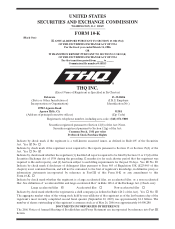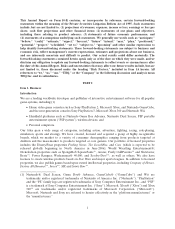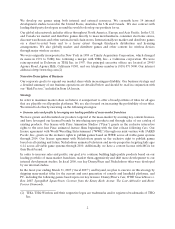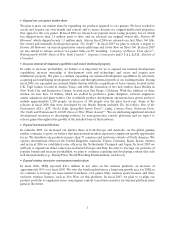THQ 2006 Annual Report Download - page 16
Download and view the complete annual report
Please find page 16 of the 2006 THQ annual report below. You can navigate through the pages in the report by either clicking on the pages listed below, or by using the keyword search tool below to find specific information within the annual report.8
titles and prepare a range of promotional sales and marketing materials to increase awareness among
retailers.
We strive to create global brand awareness for our products. Consistent with our strategy to build and
maintain franchise properties with global appeal, our international marketing efforts include localization
of products to conform to consumer preferences and languages in the countries in which each title is
distributed. This structure is designed to maximize market performance in all territories.
North American Sales. In North America, our products are primarily sold directly to mass merchandisers,
consumer electronics stores, discount warehouses and national retail chain stores. Our products are also
sold to smaller, regional retailers, as well as distributors who, in turn, sell our products to retailers that we
do not service directly, such as grocery and drug stores. Our domestic sales activities are led by our
national sales team, whichhas representatives in most major markets in the United States.
We utilize electronic data interchange with most of our major North American customers in order to
(i) efficiently receive, process, and ship customer product orders and (ii) accurately track and forecast sell-
through of products to consumers in order to determine whether to order additional products from the
manufacturers. We believe that the direct relationship model we use in North America allows us to better
manage inventory, merchandise and communications.We ship most of our products to our domestic
customers from warehouses located in Canada, Michigan and Minnesota.
The domestic retail prices for our titles currently range between: (i) $15 and $35 for handheld platforms;
(ii) $15 and $65 for console platforms; and (iii) $10 and $55 for PC games. The domestic retail price for
our wireless games currently range between $5 and $8 for a one time purchase and between $2 and $4 for a
monthly subscription.
International Sales. Our international sales activities operate via our offices in the United Kingdom,
Australia, France, Germany, Korea, Japan, Spain, Austria, Denmark and The Netherlands. International
offices market and distribute direct-to-retail customers and through sub-distributors in both their home
territories and to approximately 70 additional territories.
Our largest customers worldwide include Best Buy, GameStop, Target, Toys “R” Us and Wal-Mart. We
also sell our products to other national and regional retailers, discount store chains and specialty retailers.
Our largest customer, Wal-Mart, accounted for 19% of our worldwide sales in fiscal 2006. A substantial
reduction, termination of purchases, or business failure by any of our largest customers would have a
material adverse effect on us.
Seasonality
The interactive entertainment software market is highly seasonal, with sales typically significantly higher
during the third quarter of our fiscal year, due primarily to the increased demand for interactive games
during the year-end holiday buying season.
Competition
The video game industry is intensely competitive. It is characterized by the continuous introduction of new
titles and thedevelopment of new technologies. Our business is driven by hit titles, which requires us to
invest significantly in production and in marketing. Competition inthe video games segment is also based
on product quality and features, timing of product releases, brand-name recognition, access to distribution
channels, and effectiveness of marketing and price.
























